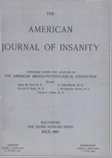42. HUMORAL CHANGES IN THE TREATMENT OF SCHIZOPHRENIA WITH PROLONGED NARCOSIS
Abstract
In our study of the humoral changes in our patients with prolonged narcosis (Cloetta's Mixture) we may provisionally point out the following results:
1. The morphological blood changes show most strikingly in the number of leukocytes and in the shift to the left in the leukocytic equilibrium, with esinopenia and neutrophilia.
2. The sedimentation reaction of erythrocytes showed a rise in all the cases but not always of the same degree.
3. The changes in the protein content and protein metabolism present themselves as follows: in most of the cases there was a decrease in the total protein, in the albumin content and the protein coefficient with a synchronous increase in the globulin fraction, the amino nitrogen and the polypeptides. These changes we ascribe primarily to the toxic effects of Cloetta's Mixture.
4. We did not succeed in establishing any correlation whatever between the effectiveness of the treatment and the changes in the proteins and protein metabolism; one can only point out that the changes in the protein content and protein metabolism were quite marked both in the cases where there was a therapeutic effect and in those where there was none.
5. The sugar values varied during the narcosis within the limits of normal, but in individual cases there were sporadically hyperglycemia and hypoglycemia. Upon the awakening the sugar values showed a definite rise, especially in the cases where the awakening was ushered in with confusion and excitement.
6. In most cases the potassium values fell during the first days of the narcosis but did not pass the lower limits of normal. The calcium showed a certain tendency to rise, but not an equal rise in all cases, nor on the same days of the narcosis.
7. The bromide content fell in most of the cases during the narcosis: near the end of the narcosis and especially after its ending the bromide rose to its original level.
8. The chloride content ran almost constantly parallel to the bromide content. These changes in the bromide and chloride contents we are inclined to think, are to be ascribed rather to a certain state of hunger of the organism (increased excretion of chlorides) than to the narcosis.
9. With reference to the iodide we could not see any regularity; in some of the cases there was a rise in the iodide content during the narcosis and in others there was a fall.
Access content
To read the fulltext, please use one of the options below to sign in or purchase access.- Personal login
- Institutional Login
- Sign in via OpenAthens
- Register for access
-
Please login/register if you wish to pair your device and check access availability.
Not a subscriber?
PsychiatryOnline subscription options offer access to the DSM-5 library, books, journals, CME, and patient resources. This all-in-one virtual library provides psychiatrists and mental health professionals with key resources for diagnosis, treatment, research, and professional development.
Need more help? PsychiatryOnline Customer Service may be reached by emailing [email protected] or by calling 800-368-5777 (in the U.S.) or 703-907-7322 (outside the U.S.).



